![]()
![]()
![]()
Use LEFT and RIGHT arrow keys to navigate between flashcards;
Use UP and DOWN arrow keys to flip the card;
H to show hint;
A reads text to speech;
37 Cards in this Set
- Front
- Back
|
Hormone |
Chemical signal that are secreted into circulatory system and communicate messages in the body (metabolism and development) Reach all parts of the body but only target cells that have receptors for that hormone |
|
|
Digestive hormones |
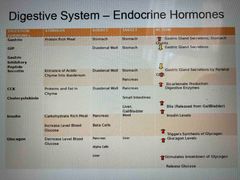
A |
|
|
More digestive hormones |
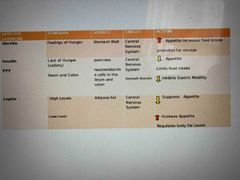
A |
|
|
Immune system local regulators chart |
A |
|
|
Hormone regulation water balance, kidney function, and blood pressure chart |
A |
|
|
2 systems of communication and regulation |
Endocrine: chemical signaling by hormones (reproduction, development, metabolism, growth, behavior) Nervous: neurons that transmit signals along dedicated pathways (neurons, muscle cells, endocrine cells) These systems often overlap creating the neuroendocrine system (neurons regulating release of hormones) |
|
|
intracellular communication (2 classifications) |
Communications btw cells and secreted signals :2 criteria for classification: 1. the route taken by signal in reaching its target 2. The type of secreting cell |
|
|
5 types of intercellular communication |
1. Endocrine signaling 2. Paracrine signaling 3. Autochrome signaling 4. Synaptic signaling 5. Neuroendocrine signaling |
|
|
Endocrine signaling |
Secreted molecules diffuse into blood stream and trigger response in target cells anywhere in the body |
|
|
Paracrine signaling |
Secreted molecules diffuse locally and trigger a response in neighboring cells |
|
|
Autoendocrine signaling |
Secreted molecules diffuse locally and trigger response in the cells that secrete them |
|
|
Synaptic signaling |
NTs diffuse across synapses and trigger responses in cells of target tissues (neurons, glands, muscles) |
|
|
Neuroendocrine signaling |
Neurohormones diffuse into bloodstream and trigger responses in target cells anywhere in body |
|
|
Local regulators |
Act on target cells within seconds or less Short distance Regulates blood pressure, nervous system function and reproduction
|
|
|
Nitric oxide |
When blood oxygen level drop endothelial cells synthesize and release NO. NO activates the relaxation of surrounding smooth muscle cells, dilating the walls of blood vessels and improving blood flow to tissue (vasodilation) NO plays role in producing an erection in men. Viagra prolongs activity of the NO response pathway |
|
|
Polypeptide local regulators |
Cytokines (immune response) Growth factors (proliferation and differentiation) -Granulocyte-macrophage colony stimulating factor -platelet/derived growth factors -epidermal growth factor |
|
|
Fatty acid local regulators |
Prostaglandins |
|
|
Gases hat are local regulators |
Nitric oxide |
|
|
Plays role in blood pressure regulation, nervous system function adaptive immunity and reproduction.. |
Paracrine and autocrine signaling |
|
|
Prostaglandins (PG) and reproduction |
Modified fatty acids Function in reproduction, the immune system, and blood clotting ie: male prostate gland secretes PGs into semen, triggering contractions of uterine wall for sperm to reach egg ie: female PGs secreted by placenta cause uterine muscles to become more excitable, helping to induce uterine contractions during childbirth |
|
|
PGs and immune system |
PGs (macrophages) promote fever and inflammation Increase sensation of pain Anti-inflammatoryeffects of aspirin and ibuprofen are due to drugs inhibition of PG synthesis |
|
|
PGs and clotting |
Regulate aggregation of platelets, one step in formation of blood clots Some people use aspirin to prevent blood clots in blood and reduce risk of heart attack |
|
|
PGs and stomach |
Help to maintain a protective lining in stomach Long term aspirin therapy can cause debilitating stomach irritation |
|
|
Nitric oxide |
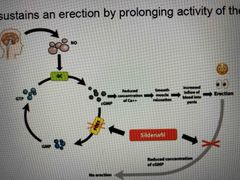
When blood oxygen level drop endothelial cells synthesize and release NO. NO activates the relaxation of surrounding smooth muscle cells, dilating the walls of blood vessels and improving blood flow to tissue (vasodilation) NO plays role in producing an erection in men. Viagra prolongs activity of the NO response pathway |
|
|
NTs and neuro hormones |
Molecules secreted by neurons that travel short distance and bind to receptors on target cells Neurohormones: secreted by neurosecretory cells into the bloodstream (ADH is an example of this) |
|
|
Maintains homeostasis, mediates responses to stimuli, regulates growth and development... |
Endocrine signaling Coordinates responses to stress, dehydration, and low glucose levels through hormones Hormones also trigger sexual maturity and reproduction changes |
|
|
Classes of hormones |

Polypeptides: insulin is made up of 2 poly. Chains formed by cleavage of longer protein chain Amines: epinephrine, oxytocin, and thyroxine synthesized from amino acid tyrosine Or tryptophan Steroids: cortisol, ecdysteroid are lipids that contain 4 fused carbon rings (derived from steroid cholesterol) |
|
|
Water-soluable hormones |
Polypeptide and amines |
|
|
Largely nonpolar hormones are lipid-soluble |
Steroid hormones |
|
|
How water-soluble hormones work |
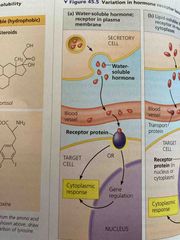
Secreted by exocytosis travel freely in the in the bloodstream and bind to cell-surface receptors Makes changes in cytoplasmic molecules Binding of a hormone to its receptor initiates a signal transduction pathway leading to responses in the cytoskeleton, enzyme activation or a change in gene expression |
|
|
Signal transduction pathway |
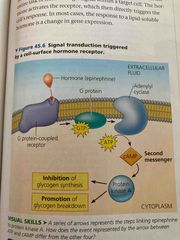
Converts extracellular chemical signal to a specific intracellular response Hormone epinephrine (secreted by adrenal) has multiple effects in mediating the body’s response to ST stress Epi binds to receptors (g protein linked) on plasma membrane of liver cells Triggers synthesis of cyclic AMP (short lived 2nd messenger) CAMP activated protein kinase A which activated an enzyme that breaks down glycogen. Also inactivates enzyme that synthesizes glycogen Liver releases glucose into bloodstream providing fuel needed to sea with stressful situation |
|
|
Lipid-soluble hormones |
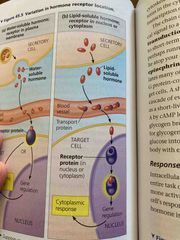
Diffuse across membrane, travel in bloodstream bound to transport proteins and diffuse through membrane of target cell Bind to intrareceptors in cytoplasm or nucleus of the target cell which triggers change in gene transcription |
|
|
Perform entire task of transduction games a signal within target cell... |
Lipid-soluble hormones |
|
|
Cytosolic receptor |
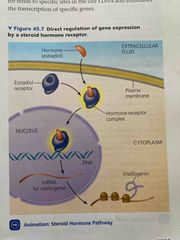
A hormone-receptor complex that steroid hormones bind to Receptors are already present in cytoplasm. Complex Moves into nucleus of cell changing gene expression. Receptor part acts a transcription regulator and interacts with DNA protein to form steroid Vitellogen which forms yolk |
|
|
Other lipid-soluble hormones |
That are not steroid hormones bind with receptors located in the nucleus (thyroxine, vitamin D) The receptor binds to specific sites in the cells DNA and stimulate transcription of genes |
|
|
Multiple effects of hormones |
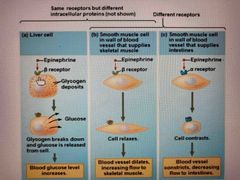
Many hormones illicit multiple responses depending on target molecule Effects vary based on different receptors for the hormone and different signal transduction pathways ie: epinephrine simultaneously triggers glycogen breakdown in the liver, decreased blood flow to digestive tract and increased blood flow to skeletal muscles |
|
|
Endocrine tissues and organs secrete hormones |
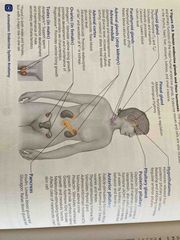
Some endocrine cells are found in organs and tissues that are part of organ systems (stomach contains for secrete gastrin) Other endocrine cells are grouped in ductless organs (endocrine glands which secrete hormones into fluid to diffuse into circulatory system) Excocrine glands have ducts that secrete substances (salivary glands) |

